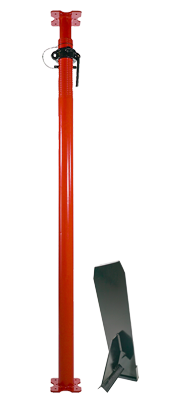Engineering:Acrow prop
An Acrow prop or BS prop is a piece of construction equipment. It is a telescopic tubular steel prop, used as a temporary support. A jackscrew is similar but not as long and not telescopic.
Outside the UK an Acrow prop may be known as a jack post, adjustable post, telescoping prop or ... post, screw jack, adjustable steel column, adjustable steel prop or ... post, adjustable metal prop or ... post, as well as an adjustable shoring post or shore post. Mistakenly the term Lally column is sometimes used as well.
Trench struts are of similar design but are meant to be used horizontally and have upturned corners on the end plates to facilitate installation by giving a claw grip to timber walings.[1]
Acrow props are adjustable for height in two ways: a loose pin through a series of holes in the inner tube gives a wide range of coarse adjustment and a large diameter screw thread formed on the outside of the tube itself provides a fine adjustment over a short range. The screw thread also allows the props to be tightened when already in place, to adjust the load that each one bears.
Props are made in a range of five BS standard sizes:[1]
- size 0 from 3.5 feet (1.1 m) to 6 feet (1.8 m),
- size 1 from 5.75 feet (1.75 m) to 10.25 feet (3.12 m),
- size 2 from 6.5 feet (2.0 m) to 11 feet (3.4 m),
- size 3 from 8 feet (2.4 m) to 13 feet (4.0 m),
- size 4 from 10.5 feet (3.2 m) to 16 feet (4.9 m).
The safe working load (SWL) for a given prop varies according to the distance between its ends and the eccentricity of the load relative to the longitudinal axis of the prop.
The safe load for a BS standard prop is a maximum of 35 kilonewtons (7,900 lbf) at a length of 2 metres (without using any attachment and when not supported by horizontal lacing). This allows 1.5° out of plumb (out of a vertical position) when loaded concentrically. Safe load is reduced when props are further extended, or by up to half when the load is not concentrical.[1]
Acrow props are mostly used for shoring: temporary supports during building repair or alteration work. A typical use is to support an existing horizontal beam when its original masonry supports are removed or repaired. When masonry itself is to be supported, holes are first knocked through the brickwork and a strong 'needle' or 'masonry support' is placed through the hole. A pair of acrow props are then used, one under each end. Existing windows or doorways may be supported directly, or via needles.
The base and top plate of acrow props are quite small, so they are suitable for supporting a vertical load but are at risk of toppling if there is any sideways force. In such cases, props should be strutted or 'laced' with scaffolding poles. A recent improvement to acrow props is to shape this baseplate with notches, allowing pallet loads of horizontal props to be stacked neatly, rather than randomly piled.
Although the original acrow prop was only intended for vertical support, the range has since been extended. Shoring 'push and pull' props with swivelling footplates are available and are used to support concrete formwork. Horizontal strutting props are used for shoring trench work. These are similar, but have a 'claw' form to their baseplates.
Acrow props, their size, strength and construction, are now described by British Standard BS1065:1999.[2] A similar lightweight European prop design exists; these have a maximum capacity of 5 kilonewtons (1,100 lbf).[1]
History
The props were invented by Swiss-born William de Vigier, who came to London in 1935.[3] At first traditionalism amongst builders preferred the established timber props, cut to fit for each job. The break for Vigier's adjustable props came when they were adopted by a few large builders, including Sir Robert McAlpine. By 1939, over 40,000 Acrow props were in use.[3]
Vigier's company was named the Acrow Group, after his solicitor Mr A Crowe. He adopted this name as, like Kodak, it was an easily pronounceable neologism, with the additional advantage of appearing early in alphabetical lists.[3]
References
- ↑ Jump up to: 1.0 1.1 1.2 1.3 "BS Props" (pdf). khk-scaffolding.com. http://www.khk-scaffolding.com/pdf/Props.pdf.
- ↑ British Standard BS1065:1999
- ↑ Jump up to: 3.0 3.1 3.2 "Obituary: William de Vigier". Daily Telegraph. 12 Jan 2004. https://www.telegraph.co.uk/news/obituaries/1451424/William-de-Vigier.html.


